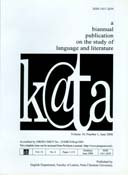A thematic analysis of Palahniuk’s fiction in light of Epicureanism
Keywords:
Epicurus, Chuck Palahniuk, Contemporary American Fiction, Ataraxia
Abstract
Chuck Palahniuk is a contemporary American writer whose novels have been adapted into acclaimed Hollywood motion pictures. Palahniuk’s literary style is often branded as modernist with nihilistic undertones. In spite of such views, in this article, we argue that through a close reading of Palahniuk and a critical interpretation of the recurrent themes in his novels, one can find traces of Epicurean philosophy echoed through the ages. Though different in means, both Palahniuk and Epicurus seem to highlight the importance of and the strive for achieving a state of ataraxia through overcoming fear and aponia through transcending physical pain and torment. After providing an introduction to Epicurean thought and Palahniuk’s style and works, connections will be established between the various shared elements and themesDownloads
Download data is not yet available.
References
Bernaerts, L. (2009). Fight club and the embedding of delirium in narrative. Style, 3(43), 373-88.
Boon, K. A. (2003). Men and nostalgia for violence: culture and culpability in Chuck Palahniuk's
fight club. The Journal of Men's Studies. 3(11), 267-276.
Bunn, A. (2008). Open book: Chuck Palahniuk writes stories that fearlessly expose the darkest parts of the human experience. So why is it that when it comes to his sexuality there are still some things he likes to keep hidden? The Advocate, 18, 42-64.
Conner, S. (2004). The Cambridge companion to postmodernism. Cambridge, UK: Cambridge University Press.
Copleston, F. (1993). A history of philosophy volume I. New York, NY: Doubleday.
D., C. & Jung, C. (1979). C. G. Jung collected works. The American Journal of Psycho-logy, 92(4), 754.
DeWitt, N. W. (1964). Epicurus & his philosophy. Minneapolis, MN: University of Minnesota Press.
Groønstad, A. (2003). One-dimensional men: Fight club and the poetics of body. Film Criticism, 1(28), 1-8.
Inwood, B. (2000). Epictetus: Discourses book I. Philosophical Review, 109(4), 639-642.
Johnson, C. (1999). Derrida (1st ed.). New York: Routledge.
Jones, H. (2016). Epicurean tradition (1st ed.). [Place of publication not identified]: Routledge.
Keesey, D. (2016). Understanding Chuck Palahniuk. South Carolina: The University of South Caro¬lina Press.
O'Keefe, T. (2014). Epicureanism (1st ed.). Hoboken, NJ: Taylor and Francis.
Palahniuk, C. (1996). Fight club. New York, NY: Henry Holt & Co.
Palahniuk, C. (1999). Invisible monsters. London, UK: W. W. Norton & Company.
Ramey, M. (2014). Studying fight club (1st ed.). Leighton Buzzard, England: Auteur.
R. F. A. (2002). The Capitalist cuckoo's nest. Human Architecture, 1(1), 1-8.
Sartain, J. (2005) Even Mona Lisa’s falling apart: The cultural assimilation of scientific epis¬temologies in Palahniuk’s fiction. Stirrings Still, 2(2), 25-47.
Thrasher, J. (2012). Reconciling justice and pleasure in epicurean contractarianism. Ethical Theory And Moral Practice, 16(2), 423-436.
Warren, J. (2006). Epicurus and democritean ethics (1st ed.). Cambridge, UK: Cambridge University Press.
Wilson, C. (2013). Epicureanism at the origins of modernity (1st ed.). Oxford, UK: Clarendon Press.
Boon, K. A. (2003). Men and nostalgia for violence: culture and culpability in Chuck Palahniuk's
fight club. The Journal of Men's Studies. 3(11), 267-276.
Bunn, A. (2008). Open book: Chuck Palahniuk writes stories that fearlessly expose the darkest parts of the human experience. So why is it that when it comes to his sexuality there are still some things he likes to keep hidden? The Advocate, 18, 42-64.
Conner, S. (2004). The Cambridge companion to postmodernism. Cambridge, UK: Cambridge University Press.
Copleston, F. (1993). A history of philosophy volume I. New York, NY: Doubleday.
D., C. & Jung, C. (1979). C. G. Jung collected works. The American Journal of Psycho-logy, 92(4), 754.
DeWitt, N. W. (1964). Epicurus & his philosophy. Minneapolis, MN: University of Minnesota Press.
Groønstad, A. (2003). One-dimensional men: Fight club and the poetics of body. Film Criticism, 1(28), 1-8.
Inwood, B. (2000). Epictetus: Discourses book I. Philosophical Review, 109(4), 639-642.
Johnson, C. (1999). Derrida (1st ed.). New York: Routledge.
Jones, H. (2016). Epicurean tradition (1st ed.). [Place of publication not identified]: Routledge.
Keesey, D. (2016). Understanding Chuck Palahniuk. South Carolina: The University of South Caro¬lina Press.
O'Keefe, T. (2014). Epicureanism (1st ed.). Hoboken, NJ: Taylor and Francis.
Palahniuk, C. (1996). Fight club. New York, NY: Henry Holt & Co.
Palahniuk, C. (1999). Invisible monsters. London, UK: W. W. Norton & Company.
Ramey, M. (2014). Studying fight club (1st ed.). Leighton Buzzard, England: Auteur.
R. F. A. (2002). The Capitalist cuckoo's nest. Human Architecture, 1(1), 1-8.
Sartain, J. (2005) Even Mona Lisa’s falling apart: The cultural assimilation of scientific epis¬temologies in Palahniuk’s fiction. Stirrings Still, 2(2), 25-47.
Thrasher, J. (2012). Reconciling justice and pleasure in epicurean contractarianism. Ethical Theory And Moral Practice, 16(2), 423-436.
Warren, J. (2006). Epicurus and democritean ethics (1st ed.). Cambridge, UK: Cambridge University Press.
Wilson, C. (2013). Epicureanism at the origins of modernity (1st ed.). Oxford, UK: Clarendon Press.
Published
2017-06-01
How to Cite
Shahriari, H., & Toosi, G. (2017). A thematic analysis of Palahniuk’s fiction in light of Epicureanism. K@ta: A Biannual Publication on the Study of Languange and Literature, 19(1), 25-31. https://doi.org/https://doi.org/10.9744/kata.19.1.25-31
Section
Articles
![]() This work is licensed under a Creative Commons Attribution License
This work is licensed under a Creative Commons Attribution License




.png)
.png)

.png)












